#Architectural theory and criticism
Explore tagged Tumblr posts
Text

Two giants of architectural criticism, Scully and Scruton.
Fresh black coffee.
Window open just a crack.
Bliss.
Gratitude.
32 notes
·
View notes
Text
Charles Correa: Architecture as a Language
The following piece of writing is a fragment of my research work at Studio SAAR, Udaipur. Various references through various media were used to synthesis this outcome. Charles Correa, one of India’s greatest architects and foremost modernists, profoundly shaped the nation’s post-independence architectural landscape. Correa’s work was not simply about buildings; it was about crafting spaces that…
#architects#architectural trends#Architecture#architecture theory#Charles correa#critical regionalism#india#Indian architects#Indian architecture#modern India#studio SAAR#Urban Design
0 notes
Note
hi!!!! hope you're doing well! i was wondering, what's the thing you most like about twisted? like what keeps you engaged and interested in the game? 😊


What keeps me in a game’s fandom is the health of the community. Even if I’m not satisfied with the official materials (*side-eyes book 2, 7, and various events*) or even if the official materials are scarce (there were hardly any new event stories early in Twst’s lifespan), it’s interesting for me to check in with the fandom and see how others are reacting.
There’s always like… creations coming out mere minutes after any news has dropped, be it fan art, theories, headcanons, cosplays, recipes, writing, or whatever else. And again, even if nothing new is coming out, there’s nothing stopping us fans from reevaluating old content, theorizing about future content, or playing around with our own OCs in the meantime. I also just love discussing the game and with my own small circle of Twst friends. Seeing everyone else be so excited or always up to something also makes me excited and want to be up to something too.
What I like the most about the game itself… I guess it’d be a mix of the art style/design and the cultures depicted in it. Twst is technically “anime” but doesn’t look like your traditional anime. I love that everyone actually has unique facial features (no Same Face Syndrome here!!) and that the artists get super experimental and creative with the makeup and fashion of the characters. A common criticism of masc. character designs is that they look so “safe” and uncreative compared to their femme counterparts, and Twst just goes and knocks it out of the park. Something else I really appreciate is how locations aren’t 1:1 just fantasy versions of real world locations. (afor example, Sunset Savanna isn’t purely Africa; it has onsen tamago, which are a Japanese food despite everything else being largely African, as well as hot springs themselves, which are also Japanesr.) Twst isn’t afraid to look at multiple cultures for reference and then blend them together to create something truly unique. And so much goes into also designing the food, customs, architecture, etc. It’s even more satisfying when they blend in Disney elements; then it becomes sort of an I Spy game of reference finding.
In terms of the writing, I think Twst is actually pretty mediocre for most events and the quality for the main story definitely varies from book to book. I feel like the characters and story would be better fleshed out and consistent were the game not a live service gacha title. When the Twst story goes hard, it goes hard. When it doesn’t it tends to fall short by a long shot. Sometimes the Disney references bog down the quality of the story too 💦 When the Disney influences are worn too strongly on the sleeve, that overtakes actually having an original and well-written plot in favor of banking on nostalgia and the Disney IP to make sales. (*stares at Lost in the Books and Tsumsted Wonderlands*)
#this ended up being sort of a critique of Twst#twisted wonderland#twst#disney twisted wonderland#disney twst#notes from the writing raven#question
127 notes
·
View notes
Text
Unnecessarily Convoluted Analysis of TWST Dorm Architecture
Putting that Art History degree to use 💪 I am getting my Masters in art history, so I am like semi qualified?? to do this. Tried my best with some of the dorms since some don't have an explicit cultural/architectural parallel irl. And obviously lots of liberties taken since I'm sure the people at Disney were not going for historical accuracy
Masterlist here
Much of this analysis can from my Spolia fic (Malleus x Light Fae MC)
Diasmonia: Early Gothic
Gothic- but early gothic. It's got a few flying buttresses, indicative of technology in later gothic movements- but in combination to the lower ceilings (lower than later gothic), fewer levels (celestory, triforium, doric columns, and shorter windows makes me think it's early gothic (more towards Norman architecture/Sens Cathedral), because it's a lot simpler and less technologically developed than high gothic (larger windows, rose windows, higher and pointier style, flying buttresses, more decorative stuff like Corinthian columns and stained glass). Still, I think the Fae would be been more concerned with its structural integrity against the waves of time- therefore gargoyles become a very prominent symbol in protecting this eternity and preservation of architecture since it basically prevents rain/weather from eating away at the building.
There's some interesting symbolism with Malleus' fixation with gargoyles, but I'm sure you can make that connection on your own based on what's out in Chapter 7 and how he reacts to both Lilia's and MC'S impending goodbyes.
Gothic was actually a term used by the French to demean the style, since it was seen as more 'savage' and 'lower' than classical architecture- which is symmetrical, solid, and values very literal and realistic (albeit idealized) characterization. Gothic architecture in contrast is a lot more airy, focuses on light and windows, and values more allegorical representations, which is why it resonated so well with the religious ruler and monarchies because they were able to not-so-subtly point to their influence and power in every single way without it being in your face all the time.
Because of this very stank contrast, it was labeled as "gothic" because people were criticizing it to be "savage" and "unkept". The goths were painted this way because they were mainly responsible for Rome's downfall, leading to the dark ages. Regardless of the French ruthlessly roasting the goths, this type of design flourished after the dark ages because technology was beginning to be advanced once more, and materials were more readily available.
My theory would be that the fae began to first develop this architecture because they had the advantage of magic, but then the humans were influenced by it- which leads them to high gothic (Noble Bell College), as well as Baroque and Rococo architecture (like the Pomefiore dorm). The Fae kept their style of early gothic since they didn't really see a point in changing much- maybe just more decorative gargoyles called grotesque as a symbol of the Fae's gratitude in their protection against time.
Also the hallways have what are almost like ribbed vaults which was one of the primary and first symbols of gothic architecture because they allowed more weight to be distributed to the vaults, and therefore allow for bigger windows.
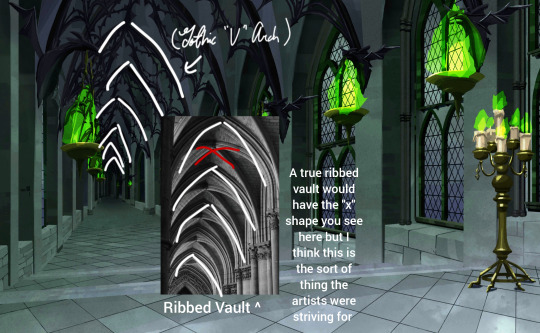
Another distict characteristics in gothic architecture are clearly defined elevations.
Traditionally, they will have the celestial at the top, then gallery, then the main arcade (especially as we get into the later gothic periods and buildings get even taller and taller). Of course Disney isn't completely accurate with these things, but it seems that they're sort of going for that vibe, as many things end up being as our contemporary notions of historical design often creates a vague iconography of things that is often a copy of a copy of a copy of the original medium.
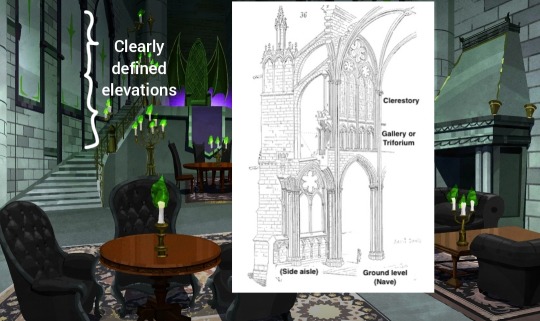
However I do think the intention to mimic the original design is still there overall, and combined with many of the other elements such as the prevalence of pointed arches that are a symbol of gothic architecture, and the sheer number of windows that were allowed originally due to the technological advances of the gothic era (and of course Malleus' own obsession with gargoyles), I think it would make sense to categorize this is like "gothic adjacent".
If I were to redesign the diasmonia dorm however, I would definitely begin by fixing the exterior- but I think they were referencing Malificent's tower in the Disney movie than any sort of historical accuracy lol. You win some, you lose some.
Pomefiore: Rococo with a touch of Art Noveau
Very obviously modeled after French Rococo architecture- the illustration of the hallways of Pomefiore dorm are almost exactly like the Palace of Versailles
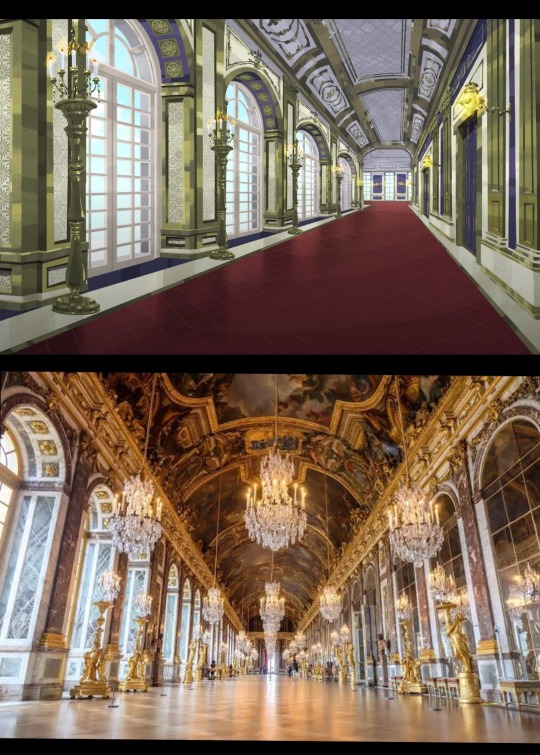
It is definitely a toned down version- but pretty spot on, right? When I first saw the Pomefiore dorm I immediately Googled a picture of the Palace of Versailles cause I knew I saw it somewhere. Autistic spidey senses at it again.
Honestly wish they went more all out with the chandeliers, and had painted ceilings on the dorm colors- but I feel like they got the general vibes right. It feels closer to Romanesque with its simplicity but it still holds an aura of decadence and frivolity that I like. Very rich, extravagant like it's members (maybe not so much Epel lol)
Elements of Art noveau in the furniture (the peacock chair) and the embroidery of the uniforms.
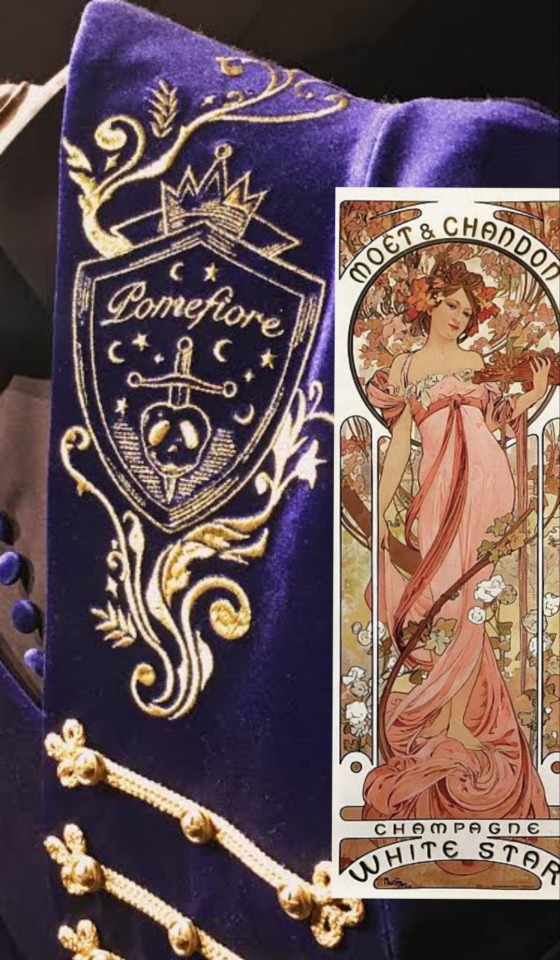
Also, the peacock chair sort of reminds me of James McNeill Whistler's Peacock Room. He was an American impressionist that was sort of the forefront of art nouveau, since impressionism was one of the mainstream movements that really began the explosion of Japanese inspired design that is also used in Art Nouveau aesthetic.
(Vil would definitely have this room if he could)
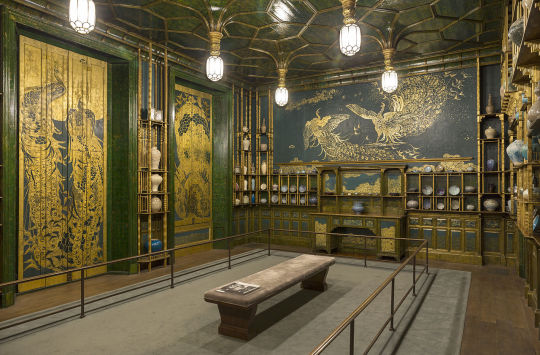
The carpet in the room reminds me of William Morris' designs, and just art nouveau in general.
As far as I can tell, the exterior is based on a variety of German castle styles from 13th century Romanesque styles, to 18th century Neo-Gothic styles. Which is coincidentally what a lot of the castles on Disneyland are based off of.

Everything is very florial, Corinthian, and extravagant. I love it. It's very baroque, I dig it.
Scarabia
Please don't come for me I'm not as well versed in Non-Asian and Non-Western architecture except for religious architecture in Turkey and Jerusalem so I'm gonna try my best with this one
So I think it mixes a lot of the icons we think of in association to Arabic architecture like domes, pointed/ogee (rounded, then pointed)/multifoil (multiple curves) arches, and ornate floral designs that derive from the use of calligraphy in Islamic structures (as iconography, or pictures depicting the faces and bodies of religious figures were not allowed).
And I think all those tiny buildings resemble Minarets, or tall towers built adjacent to mosques where the muezzin can issue the call to prayer. But the artists were probably like "hm. Not enough. How do we make it more arabic??" And of course the contemporary orientalist perspectives that dominate the artistic realm made they go "quick just add a bunch of domes"
I think Kalim's room and the lounge in particular best shows the general "airiness" that parallels Islamic acthicture (ie the Sheikh Zayed Grand Mosque on UAE)
Open air courtyards are also a characteristic element of Islam architecture, which you can see with the areal view of the dorm, and also makes sense with Kalim's unique magic.
Jali window designs (the intricate gold metal covers on the arches) are also popular on Islamic architecture
The Haga Sophia in particular has been described to have a dome "suspended by the heavens", as the section connecting the building and the dome is made entirely of arches that allows the sunlight from the heavens to pour inside the building. Though the haga Sophia is a very special case, as it was occupied by varying religions with different architectural styles at certain periods- I think it's also a good representation of our contemporary prototype of Arabian architecture that makes up the final design of the dorm.

Ignihyde: Classical Greek
Looks like it's modeled after the Parthenon, which was built during the Classical period on Greece where Athens was flourishing as a center of mathematics, technology, and architecture. These are sentiments which becomes reflected in the Renaissance afterwards, such as symmetry and a very systemic way of approaching things. I think it fits perfectly with this dorm, since they're the "tech geeks" of NRC
It's got your pediment, your doric columns (would have preferred ionic columns but whatever Disney), your arcades. Pretty straight forward unlike the actual movie it's based off of lol (Hercules has so so many mythological inconsistencies. Like why are you talking about Achilles in the movie??? Trojan was hasn't even happened babe stop manifesting that shit)
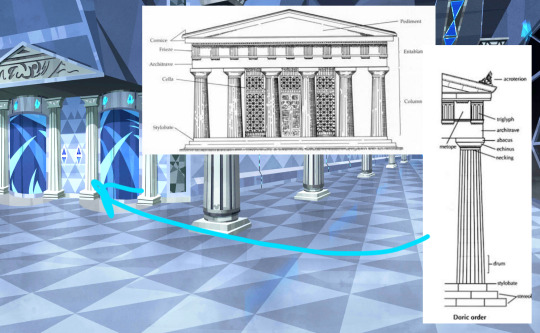
I think the symmetry and order of Classical Greek design goes well with the overall futuristic look Ignihyde and the Island of Woe are going for. Pretty clever, Disney.
Heartslabyul: Tudor Revival Style
Though Alice in Wonderland is set in the later 19th century, I think the Tudorian Revival style than began in the beginning of the 20th century just shortly later fits best.
Turdorian revival style is characterized through half timbering, which is like the timber panels you see on the surface of the building; oriel windows (windows that jut out); mock battlements; and courtyards.
The Tudorian revival style also takes elements from Elizabethan era architecture and perpendicular gothic architecture, hence the long gallery and the tudorian four point arch)
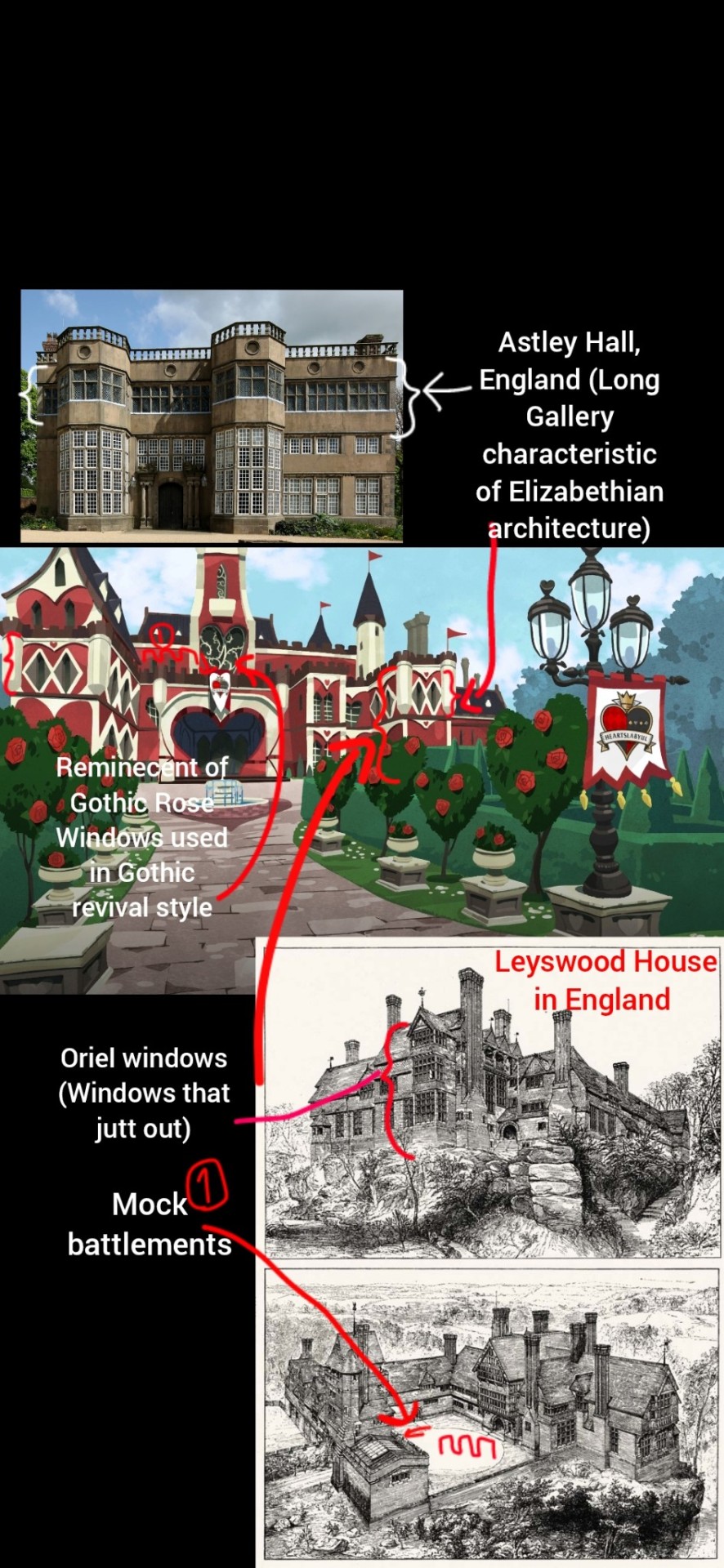
The glass panes in the lounge leaves me to believe it's sort of like a glass house where part of the house is sort of like a greenhouse. This is characteristic of Victorian glasshouses that rose with the availability of timber, paint, and brick and the popularity of botany in the Victorian era propelled by botanical imports from British colonies. Architecrs like Joseph Paxton were also known for his opus magnum- the Crystal Palace, which held the Great Exhibition of 1851 (kind of like a world expo with the theme of industry and art) also popularize the movement- and was a significant sign of wealth, as glass and window taxes were especially high. But in the later century when iron and steel frame construction was advanced, people could be built out of iron and window panes, so they could be assembled easily, and also afforded by middle class citizens.
So it's basically a mix of Elizabethan and Victorian revival styles (tudorian and gothic), which is in theme with the Victorian period the original media is set in, albeit taking inspiration from styles little later in the period.
Savanaclaw:
Again- I am blind when it comes to Non-Asian/Non-Western architecture- but this one was kinda confusing cause it really doesn't have any architectural cohesivity??? Like it's just got a general "jungle vibe" which I'm not surprised at because Disney is infamous for glossing over non-white cultures and kind of just simplifying them into a "general vibe" which wow yikes my guy
Kind of reminds me of Mese Verde, which are structures made directly within a cliffside, or the Great Mosque of Djenné and the African Heritage house in Kenya which have very smoothed, natural designs that blend into the environment
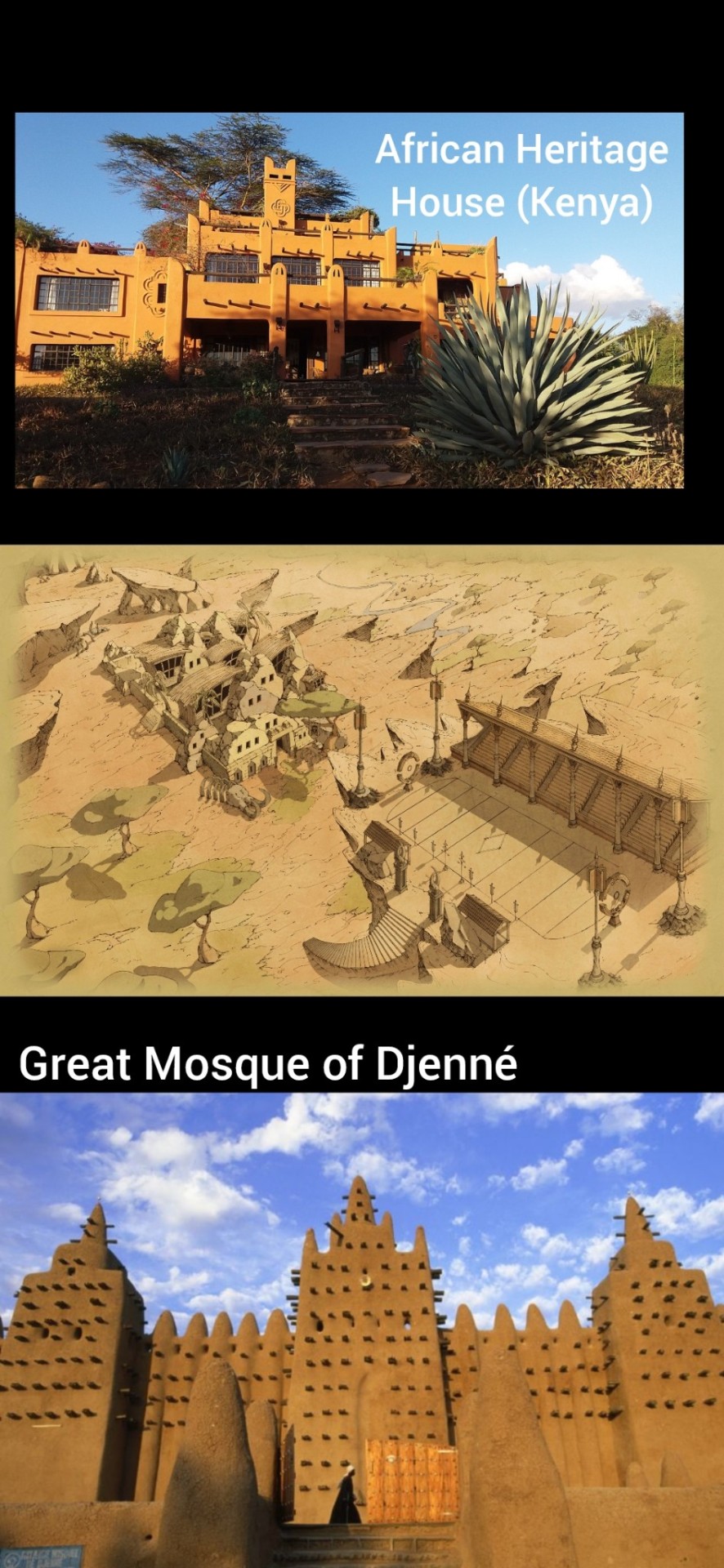
What I could gather from my research and my juicy autistic brain, savannas are regularly subjected to wild fires- so a lot of the heavy, rocky architecture and interior style makes sense, opposed to one made of wood (which are mostly in the inside of the structure, besides the roof which I imagine is less likely to catch on fire). Much of the building seems also to be directly carved within natural rock formations- a very functional use of the resources around you- very savannaclaw!
The textiles in each of the dorm members' rooms resemble Kente fabric, a style of hand weaving from Ghana, originally reserved for royalty but now commonly worn for ceremonial occasions and such. Also unlike other African textiles styles, it's strictly a male practice. I think it would make sense for Sunset Savanna, a place where women are highly respected and perhaps take on more political and military positions- leaving largely men to the practice of textile making (both are honorable acts- not comparing the two). There aren't distinguished aesthetic styles of textiles that differentiate each weaving from another- rather, it is divided by technique and region- so this is not like a definite connection, just thought it was interesting to includle
Textiles seem to occupy the only decorative role in the entire dorm- so perhaps there is significant cultural significance? Maybe there is a certain region that's known for their practices? Or is weaving a symbol of adulthood or growth and therefore is why they're hung up in each of the dorm member's rooms with the exception of Ruggie, who may not have had the socioeconomic privilege of making one? Or does the practice vary across species? Much to speculate 🤔
Octavinelle: Art Deco and Art Nouveau
Saved this one for last because oh boy I don't even know where to start with this. Obviously the design is very creative and I love it, but there's a lot less historical elements I can use to analyze the style, kind of like the Savanah claw exterior.
But it leans towards the art deco style, which is most fitting for the business dorm I think.
Elements of Art deco like geometric aspects of design, thematic and aesthetic consistency, and decorative/geometric windows are seen throughout the dorm interior and exterior
But I think the art nouveau elements are also there too, with the cheeky sea-themed elements that use natural shapes and icons into the architecture, design, and surfaces of the dorm.
Otherwise, not much else to say about this dorm 🤷 it's not really based in anything historical but there are bits and pieces of art nouveau and art deco in there, but I definitely wish they would lean more into the art deco elements since I think it would go well with the general themes of the dorm values.
So uh, yeah. Told you it would be convoluted.
Feel free to add and or correct!
#twisted wonderland x reader#twisted wonderland#twisted wonderland analysis#art history#twisted wonderland theory#diasmonia#pomefiore#ignihyde#scarabia#heartslabyul#octanivelle#savanaclaw#twisted series#twst analysis#lilia vanrouge#malleus draconia#rook hunt#vil shoenheit#epel felmier#idia shroud#ortho shroud#ace trappola#deuce spade#trey clover#carter diamond#twst silver#sebek zigvolt#architecture#leona kingscholar#ruggie bucchi
940 notes
·
View notes
Text
Ω PJO DEMIGOD HEADCANONS: 🦉 ATHENA: Goddess of Wisdom & Reason, of Strategy & Warfare, Crafts & Arts 🧠
author's note: I had a sudden idea about writing some headcanons Camp Halfblood demigods being claimed and what it's like for each respective god and cabin, followed by a small blurb afterwards. Thank you for reading and please like and reblog! The order is not in order of the cabin numbers. [PJO DEMIGOD HEADCANONS MASTERLIST]
When you get claimed, it's after a moment of brilliance. You could be giving someone an insightful observation, successfully mediating two opposing forces, creating your own invention, or when you successfully performed a maneuver. You’ve shown your intellect and Athena claims you at that moment.
The Athena cabin cheers for you and welcomes you in.
You look in awe at the architectural structure of your cabin. You can tell the foundation and the base of the cabin was structured like the rest of the other cabins, but over the years, it was elevated.
You’re shown where you’ll be sleeping but as you set up, you immediately clock in how everything is placed. All the bunks are pushed to the side, row by row and then there are desks lining along the same way with dual tables, and there are the rows of books and a workshop further in the back. You see inventions being made, architectural models, and more.
Among the children of Athena, you slowly figure out which intellectual you lean more towards: Educated (developing theories and plans), Productive (philosophy, literary criticism, sociology, law, medicine, etc), or an Artistic (literature, music, painting, sculpture, etc). Whichever you are or of those you find yourself in, you’re in good company.
If you want to bounce off ideas of someone, there’s no shortage of siblings to have a sound board of.
Whatever craft you find yourself in, you’re immediately put into consultation and you find yourself either being asked to get an input on or seeking input from others.
Fortunately and unfortunately, since demigods aren’t allowed to use the internet, your cabin is the next best option for Google.
Spider repellents everywhere. There’s not a single dust bunny in sight, not even in the corners or behind the unseen books. Aside from the piling books, scrolls, and tools (and the few coffee cups), the Athena cabin is the cleanest cabin after the Apollo cabin.
When there was a spider somehow, you witness everyone scream and grab several torches before incinerating the arachnid into nothingness.
That or an overly complicated set up of a machine to destroy that one spider. Then you find out that there’s a lot of contraptions that they’ve built for one, very specific, function.
You just had pulled off an emergency strategy maneuver during the Capture the Flag. It was a close call with the new camper but you couldn’t mistake them for not being a child of Ares. They were a monster on the field and you had to make sure at least get some upper hand.
You managed to take out half of the other team’s numbers, using the layout of the forest and its terrain to your advantage, and your eyes noticing the body language of your opponent.
You still lost because the new camper, who has the undeniable glow of Ares on them, demolished through your forces, but it wasn’t half-bad since the casualty was the same on both sides.
“You’re fast on your feet. A bit foolish, but it was a nice maneuver.”
You jumped at the voice and turned to it, seeing a blonde girl with gray eyes. You knew her, Annabeth Chase, daughter of Athena.
“Oh, uh, yeah” you said lamely, dusting yourself off as an attempt to keep your hands from shaking. “I figured at that point, we could at least make it fair or we just lose really badly.”
Annabeth nodded, as she smiled. “I guess, there’s plenty of time to hone your intelligence with us.”
“Wait what?”
Annabeth gestured up your head and you looked to see the glowing image of an owl over your head. You made a “oh” and looked owl-eyed at your new sister as she held out her hand.
“Welcome to the Athena cabin, I’m Annabeth Chase. Cabin Leader and your new half-sibling.”
#pjo fanfic#pjo imagine#annabeth chase#percy jackson and the olympians imagines#pjo#pjo imagines#pjo x reader#pjo reader insert#annabeth pjo imagines#annabeth chase imagines#annabeth chase imagine#child of athena#children of athena#athena#pjo x you#demigod h/cs#demigod reader#demigod headcanons#demigod imagines#athena cabin#cabin 6#percy jackson and the olympians imagine#percy jackon and the olympians
257 notes
·
View notes
Text







Venice in the art of Alexandra Exter (1882-1949)
Carnival in Venice (oil on canvas) 1930s
Carnival Procession (oil on canvas)
Masked Figures by the Banks of a Venetian Canal (oil on canvas)
Venetian Masks (oil on panel)
Pulcinella (gouache on paper) late 1920s-30s
Venice (oil and sand on canvas) 1925
Venice, 1915
"Aleksandra Aleksandrovna Ekster, also known as Alexandra Exter, was a Russian and French painter and designer. As a young woman, her studio in Kiev attracted all the city's creative luminaries, and she became a figure of the Paris salons, mixing with Picasso, Braque and others. She is identified with the Russian/Ukrainian avant-garde, as a Cubo-futurist, Constructivist, and influencer of the Art Deco movement. She was the teacher of several School of Paris artists such as Abraham Mintchine, Isaac Frenkel Frenel and the film directors Grigori Kozintsev, Sergei Yutkevich among others." [x]
"Exter painted views of Florence, Genoa and Rome, but ‘most insistent and frequent were images of Venice. The city emerged in various forms: via the outlines of its buildings, in the ‘witchcraft of water’. In glimmering echoes of Renaissance painting, in costumes and masks and its carnivals’.
"Exter’s characteristic use of the bridge as a stage platform, seen most clearly in Carnival in Venice, is a legacy of her time as Tairov’s chief designer [Alexander Tairrov, director of Moscow's Kamerny Theatre]; the director believed in breaking up the flatness of the stage floor which the artist achieved for him by introducing arches, steps and mirrors. Even in her easel work, the emphasis is at all times on theatricality. Bridges are used as proscenium arches, the architecture creates a stage-like space in which to arrange her cast."
"For all her modernity, references to Venetian art of the past abound in these paintings. The masked figures are influenced by the Venetian artist Pietro Longhi, to whom Exter dedicated a series of works around this time. The incredible blues used in both Carnival Procession and Masked Figures by the Banks of a Venetian Canal are a direct reference to Titian, who was famed for his use of ultramarine, the pigment most associated with Venice’s history as the principal trading port with the East." [x]
"Exter had long since abandoned the Cubist syntax by 1925 but her sense of colour remained together with a strong conviction, shared with Léger, that a work of art should elicit a feeling of mathematical order. In its graceful interaction of fragmented planes and oscillation between emerging and receding elements, Venice (1925) echoes the more precise qualities that also appear in Léger's work at this time, both artists occupied with the continuous modulation of surfaces and the 'melody of construction' that Le Corbusier was still advocating in the 1930s. But while Exter subscribed to Léger's theory that 'a painting in its beauty must be equal to a beautiful industrial production', she never fully embraced the aesthetics of the machine and rejecting the common opposition between ancient and modern, her work often retains a classical edge - for example in these trefoil windows, arches and vaults. Human figures, which had been nearly absent from her Cubo-futurist paintings, also return in other works from this period."
"She was undoubtedly aware of the concept of 'defamiliarisation', a term first coined by the influential literary critic Viktor Shklovsky in 1917:
'The purpose of art is to impart the sensation of things as they are perceived and not as they are known. The technique of art is to make objects 'unfamiliar,' to make forms difficult to increase the difficulty and length of perception because the process of perception is an aesthetic end in itself and must be prolonged.'
An instance of this device is discernable in the present tight formation of the oars, seen from above. Like Braque and Picasso, Exter incorporates sand into certain areas of pigment to enhance the differentiation of surfaces, a technique also used to 'increase the length of perception'. The occasional lack of overlap between the boundaries of the textured surfaces and colour planes strengthens the paradoxical combination of tangible presence and elusive abstraction that makes Venice such a powerful work."
"Venetian subjects occur in Exter's work as early as 1915. A gigantic panneau of the city was one of the final works she produced in the Soviet Union and exhibited in the 1924 Venice Biennale." [x]
"The specific theme of the Commedia dell’Arte first appeared in Exter’s work in 1926 when the Danish film director Urban Gad approached her to design the sets and marionettes for a film which was to tell the story of Pulcinella and Colombina, transposing them from the Venice of Carlo Goldoni to contemporary New York. Pulcinella most likely relates to the artist’s subsequent experimentations on the theme of the Commedia dell’Arte. Pulcinella, who came to be known as Punch in England, is one of the classical characters of the Neapolitan puppetry. Typically depicted wearing a pointed hat and a mask, Pulcinella is an opportunist who always sides with the winner in any situation and fears no consequences." [x]
52 notes
·
View notes
Note
Yo, I saw your post about orientalism in relation to the "hollywood middle-east" tiktok!
How can a rando and university dropout get into and learn more about? Any literature or other content to recommend?
Hi!! Wow, you have no idea how you just pressed a button. I'll unleash 5+ years on you. And I'll even add for you open-sourced works that you can access as much as I can!
1. Videos
I often find this is the best medium nowadays to learn anything! I'll share with you some of the best that deal with the topic in different frames
• This is a video of Edward Said talking about his book, Orientalism. Said is the Palestinian- American critic who first introduced the term Orientalism, and is the father of postcolonial studies as a critical literary theory. In this book, you’ll find an in-depth analysis of the concept and a deconstruction of western stereotypes. It’s very simple and he explains everything in a very easy manner.
• How Islam Saved Western Civilization. A more than brilliant lecture by Professor Roy Casagranda. This, in my opinion, is one of the best lectures that gives credit to this great civilization, and takes you on a journey to understand where did it all start from.
• What’s better than a well-researched, general overview Crash Course about Islam by John Green? This is not necessarily on orientalism but for people to know more about the fundamental basis of Islam and its pillars. I love the whole playlist that they have done about the religion, so definitely refer to it if you're looking to understand more about the historical background! Also, I can’t possibly mention this Crash Course series without mentioning ... ↓
• The Medieval Islamicate World. Arguably my favourite CC video of all times. Hank Green gives you a great thorough depiction of the Islamic civilization when it rose. He also discusses the scientific and literary advancements that happened in that age, which most people have no clue about! And honestly, just his excitement while explaining the astrolabe. These two truly enlightened so many people with the videos they've made. Thanks, @sizzlingsandwichperfection-blog
2. Documentaries
• This is an AMAZING documentary called Reel Bad Arabs: How Hollywood Villifies A People by the genius American media critic Jack Shaheen. He literally analysed more than 1000 movies and handpicked some to showcase the terribly false stereotypes in western depiction of Arab/Muslim cultures. It's the best way to go into the subject, because you'll find him analysing works you're familiar with like Aladdin and all sorts.
• Spain’s Islamic Legacy. I cannot let this opportunity go to waste since one of my main scopes is studying feminist Andalusian history. There are literal gems to be known about this period of time, when religious coexistence is documented to have actually existed. This documentary offers a needed break from eurocentric perspectives, a great bird-view of the Islamic civilization in Europe and its remaining legacy (that western history tries so hard to erase).
• When the Moors Ruled in Europe. This is one of the richest documentaries that covers most of the veiled history of Al-Andalus (Muslim Spain). Bettany Hughes discusses some of the prominent rulers, the brilliance of architecture in the Arab Muslim world, their originality and contributions to poetry and music, their innovative inventions and scientific development, and lastly, La Reconquista; the eventual fall and erasure of this grand civilization by western rulers.
3. Books
• Rethinking Orientalism by Reina Lewis. Lewis brilliantly breaks the prevailing stereotype of the “Harem”, yk, this stupid thought westerns projected about arab women being shut inside one room, not allowed to go anywhere from it, enslaved and without liberty, just left there for the sexual desires of the male figures, subjugated and silenced. It's a great read because it also takes the account of five different women living in the middle east.
• Nocturnal Poetics by Ferial Ghazoul. A great comparative text to understand the influence and outreach of The Thousand and One Nights. She applies a modern critical methodology to explore this classic literary masterpiece.
• The Question of Palestine by Edward Said. Since it's absolutely relevant, this is a great book if you're looking to understand more about the Palestinian situation and a great way to actually see the perspective of Palestinians themselves, not what we think they think.
• Arab-American Women's Writing and Performance by S.S. Sabry. One of my favourite feminist dealings with the idea of the orient and how western depictions demeaned arab women by objectifying them and degrading them to objects of sexual desire, like Scheherazade's characterization: how she was made into a sensual seducer, but not the literate, brilliantly smart woman of wisdom she was in the eastern retellings. The book also discusses the idea of identity and people who live on the hyphen (between two cultures), which is a very crucial aspect to understand arabs who are born/living in western countries.
• The Story of the Moors in Spain by Stanley Lane-Poole. This is a great book if you're trying to understand the influence of Islamic culture on Europe. It debunks this idea that Muslims are senseless, barbaric people who needed "civilizing" and instead showcases their brilliant civilization that was much advanced than any of Europe in the time Europe was labelled by the Dark Ages. (btw, did you know that arabic was the language of knowledge at that time? Because anyone who was looking to study advanced sciences, maths, philosophy, astronomy etc, had to know arabic because arabic-speaking countries were the center of knowledge and scientific advancements. Insane, right!)
• Convivencia and Medieval Spain. This is a collection of essays that delve further into the idea of “Convivencia”, which is what we call for religious coexistence. There's one essay in particular that's great called Were Women Part of Convivencia? which debunks all false western stereotypical images of women being less in Islamic belief. It also highlights how arab women have always been extremely cultured and literate. (They practiced medicine, studied their desired subjects, were writers of poetry and prose when women in Europe couldn't even keep their surnames when they married.)
4. Novels / Epistolaries
• Granada by Radwa Ashour. This is one of my favourite novels of all time, because Ashour brilliantly showcases Andalusian history and documents the injustices and massacres that happened to Muslims then. It covers the cultural erasure of Granada, and is also a story of human connection and beautiful family dynamics that utterly touches your soul.
• Dreams of Trespass by Fatma Mernissi. This is wonderful short read written in autobiographical form. It deconstructs the idea of the Harem in a postcolonial feminist lens of the French colonization of Morocco.
• Scheherazade Goes West by Fatma Mernissi. Mernissi brilliantly showcases the sexualisation of female figures by western depictions. It's very telling, really, and a very important reference to understand how the west often depicts middle-eastern women by boxing them into either the erotic, sensual beings or the oppressed, black-veiled beings. It helps you understand the actual real image of arab women out there (who are not just muslims btw; christian, jew, atheist, etc women do exist, and they do count).
• Letters of Lady Mary Wortley Montagu. This is a feminist travel epistolary of a British woman which covers the misconceptions that western people, specifically male travelers, had recorded and transmitted about the religion, traditions and treatment of women in Constantinople, Turkey. It is also a very insightful sapphic text that explores her own engagement with women there, which debunks the idea that there are no queer people in the middle east.
---------------------
With all of these, you'll get an insight about the real arab / islamic world. Not the one of fanaticism and barbarity that is often mediated, but the actual one that is based on the fundamental essences of peace, love, and acceptance.
#orientalism#literature#arab#middle east#islam#feminism#book recommendations#reference#documentary#western stereotypes#eurocentrism#queer#queer studies#gender studies#women studies#cultural studies#history#christianity#judaism#books#regulusrules recs#If you need more recs#or can’t access certain references#feel free to message me and I’ll help you out!#regulusrules answers
141 notes
·
View notes
Text
In Another Timeline, I Found A Good Title For This Post
(page 1196-1219; timeline theories)

The pacing of this intermission is kind of unbelievable – double digit pages for the past five days in a row. With that, all four members of the Midnight Crew have been introduced, so I’ve put together this quick table showing some of the patterns we’ve seen so far. About 75% of the time I spent making this was researching hat styles.
Page 1211 was the moment I really bought into this intermission. Up til now it’s been fun, but I have been missing the beta kids. But ‘You're gonna jump to a timeline where he's dead’ has really grabbed me, because this is new – as far as we know, Acts 1-3 took place in a single timeline, where loops are closed and everything’s stable. Now, the possibilities are anything. Calling it now that we’ll learn in Act 4 that a critical earlier event actually happened in a different timeline to everything else.
Also the two of spades turning into Slick’s licorice scottie dogs between panels is a really good bit. It ALMOST makes up for the ‘jack king off’ joke on page 1197, which is probably the worst joke in Homestuck so far.




This page is another highlight! Slick literally did build this town, and it looks totally different from the green-tinged complex architecture of now. I guess this is the flaw in Die’s powers – he can travel to a timeline where somebody is dead, but he can’t choose which one. He’s equally likely to get a timeline where Slick died today as one where Slick died before ever building the town. And maybe more importantly… this page looks kind of like a color switched version of page 248, another wasteland with a city in the distance (although this new one has other planets circling overhead).

So, most likely, Spades Slick and Jack Noir are versions of the same character from different timelines, and that’s why they’re not aware of each other. In the HS timeline, the character becomes a prominent agent of the dark kingdom, while in the MC timeline, he becomes an underground criminal/architect/construction worker on a planet that probably isn’t Earth, and might not even be in the Incipisphere. A city planner would fit right in with WV, PM and AR’s civic infrastructure theme. So the question is, what determines if a NPC leaves the game and returns to the outside universe? And does this mean Jack Noir could also leave, go to Earth, and be the future character who starts off in Dave’s location and flies to join the other three?
It does seem significant that on what’s apparently an alien planet, there is so much human paraphernalia. As well as the Crosbytop and Foxworthy photo, Deuce has a Stretch Armstrong doll. Surely this planet has its own celebrities to draw from. Alchemy still seems likely – Dave definitely has the components in this house to alchemize this doll. And there is a strong suggestion that appearification and sendification could work between planets or into/out of the Incipisphere – page 733 gives a good look at the screen on WV’s appearifier, which could be adjusted to the Incipisphere with the right key. That key isn’t Slick’s spade key, but someone has it. Maybe Snowman or Lord English or Diamonds Droog (who seems a fair bit more competent than Slick). And obviously we know there’s lots of Skaian technology on Earth, but it’s now possible there could be items from this other alien planet, too. Say, rocket boards.

And as a final red string theory (‘Red Strings’ title of DD’s magazine??), Boxcars hypothesizes that ‘you've got to alter the flow of time itself’ to open the Felt’s safe (p.1218). This is a story where one specific time of day has been really important, and has come up over and over again, and now there’s a whole mansion and group of previously unknown characters whose whole deal is controlling and changing time – among other things, these people can decide when it is 4:13 and when it isn’t. Clock faces are the same on this planet as they are on Earth, and the current time is 12:13pm – also the time on Jade’s island at the start of Act 3, for what it’s worth – and Boxcars’ plan to blow up this very important clock feels significant when we know that some places are outside the flow of time of the universe, AND there’s multiple timelines here, which could potentially converge if time is otherwise stopped.
I’m out here getting my head all tangled over this timeline stuff, but the Midnight Crew are not at all. Droog, especially, has this ‘just another day at the office’ familiarity with time travel. He and his crew don’t engage in it at all, but they know what’s up, and it’s no different to knowing what type of disguise or getaway car a rival gang uses. What a fucking idiot, they’ve totally given themself away with this ‘punching me from the future’ move yet again. This moment on page 1203 looks like a stable loop, even if nothing else is – Deuce has arrived after being radioed for backup, and Droog’s trail leads up the stairs, where we know he went after being punched.

Droog and Deuce are both great characters. Droog is like the second in command who’s actually way more competent than the leader. He has clear parallels with Dad Egbert, sort of Dad’s dark mirror, with the same attention to suits and to backup versions of his clothes. Dad also has multiple backup hats, although some are in different styles (p.72), multiple backup pipes, and lots of identical shoes and ties (p.948). We haven’t actually seen a DD analog on the ominous planet – only SS (p.953) and HB (p.957) – so either Dad is going to meet this DD analog, befriend him and be sheltered by him now that he’s escaped prison, OR (more compelling), he’s going to disguise himself as an ominous citizen and BECOME the DD analog in the HS timeline.
As for CD, I just think he’s neat. I love that he’s wearing two hats and one of them is a bomb.
#homestuck#reaction#getting on a long distance flight tomorrow and 413 is also the combination to my suitcase if any of yall want to rob me on the way#if youre seeing this in the future. try to rob me through time. its apparently not that hard (if you are the felt)#chrono
25 notes
·
View notes
Text
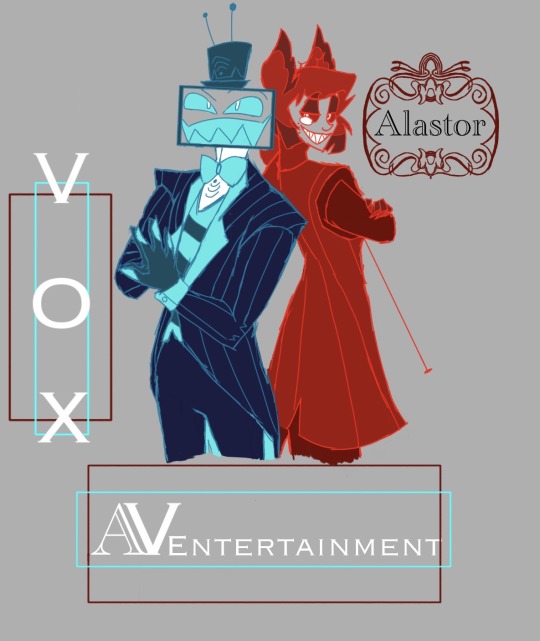
The Overlord Power Couple— this is probably a billboard or magazine cover
This was just supposed to be a sketch but yeah
• They co-own a talent agency— Vox handles TV, commercials and film, Alastor specialises in voiceover, music production and obviously radio
• Alastor is the harsher critic when it comes to talent— very much has an ‘either you have it or you don’t’ attitude
• They have two towers and actor’s village at the bottom and it’s like its own high end neighbourhood, think like a classy mashup of old and modern New York architecture
• The Agency is located on Vox’s tower, along with the meeting rooms and the sets of Vox’s programs that he hosts. Vox’s office is the top floor.
• Alastor’s tower is more a place of entertainment and indulgences— exclusive to the talent within the agency except for major events where it’s invite only. Ground floor is a restaurant, next floor is a jazz club/theatre, recording studio is on the third floor, Al’s office and radio station is the top floor.
• Events at the jazz club/theatre are the social events of the season
• Alastor writes and directs radio plays and Vox is super invested— so this has absolutely happened post episode:
Vox: *teleports to Alastor’s office and grabs his shoulders, violently shaking him* *distraught beyond belief* WHAT IS WRONG WITH YOU?! WHY WOULD YOU LEAVE IT LIKE THAT?! YOU FUCKING SADIST! I COULD KILL YOU! HOW’D YOU LIKE TO DIE AGAIN, YOU HORRIBLE PRICK?!
• There is a cork-board at home for Vox’s theories about what happens next episode— it’s on the side of the fridge so Vox remembers to eat.
• Alastor loves leaving his thoughts on post-its on what he thinks of certain theories.
• Vox has tried to sneak peaks at the script before the episode airs. He has failed miserably each attempt. Alastor is very pleased.

I’m so unwell about them actually… obsessed in the sickest most twisted way
61 notes
·
View notes
Text
sy faces his toughest challenge yet: suburbs

this is legitimately insightful commentary good job wildbow! the effects of political domination on culture!
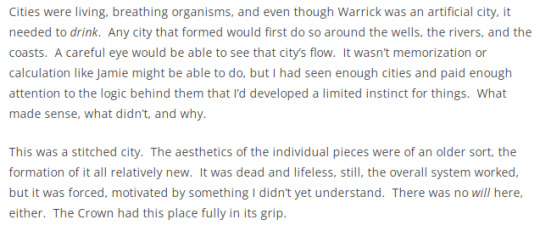
if it'd been written a hundred years earlier this might've made it into some minor piece of critical theory as a tongue-in-cheek aside. freud says that the shape of the psyche mirrors the shape of a city insofar as its built on top of ruins, ruins which may not readily present themselves but which nonetheless inform behavior and mood. this is why the baron's (much like so many american cul-de-sacs) and their eerie prefab architecture are conducive to a certain lonely, hollow dread: they lack some fundamental human quality. the sadism with which it was created seeps into its citizens. a stitched city 👌 what an evil idea
85 notes
·
View notes
Note
been thinking it for a while but it is both an interesting and frightening thing to see more and more people in their 20s who are usually self-professed hard-leftist progressives get more and more into emotionally-driven, kneejerk 'takes' about how everything new to them is bad and evil and 'this generation' (usually people younger than them who they seem to base all their opinions on from some teens dumb tiktoks they see) is stupid and doomed and the world/'our culture' is constantly degenerating, etc. many of the people who think of themselves as radical leftists are coming out with more and more barely-formed, incoherent and emotionally-driven reactionary ideas, and respond to any criticism of these ideas with defensive appeals to disgust or a general sense of 'everyone just knows this is bad!', bypassing needing to think over their own ideas or articulate the reasons they hold them entirely in favor of reactive outrage.
it feels to me like were watching in real-time how many of us will progressively turn into reactionary liberals or right-wingers - something many of these people have observed in older people, in their parents, but believe will simply not happen to them on account of having good intentions and progressive views, which they think means they dont need to watch themselves for impulsive, reactionary thinking, and even that their kneejerk reaction to anything is automatically the correct one because they themselves are already inherently good. of course it starts with generally inconsequential takes, its not like saying 'the tiles are ugly' automatically makes you a right-winger, but i reckon the festering of such modes of thinking shows the cracks in the foundation of many peoples professed political and social beliefs.
point being, i think there certainly are discussions to be had about the ways architecture - both as a tool that serves a material need and a form of art - changes, and what we may be losing to capitalist priorities on that front, but if the only argument people are making are "its ugly and degenerates our once beautiful culture" and their defense to anyone addressing how that sounds ends at "well its still ugly!", im thinking that kind of reactionary opinion-forming is going to seep into other, more important matters sooner than they may think. sorry for the long ask!
yeah i mean i definitely don't think this is a new problem or a generational one, it's just liberal idealism, but yes this is exactly why this type of aesthetic discourse irritates me so much lol. like i've said this before in regards to clothing but aesthetic signifiers gain their meaning in a social context and conditionally. if your analysis is "it's ugly and therefore bad" you're not only attenuating an actual read of what's being signified and why, you're also just veering directly into the most boring ass "everything is worse now and change threatens me" conservatism. the idea that ugliness and beauty are not transhistorical or transcendental truths should ideally be like, a starting point to both questioning other socially mediated constructs and to then moving toward a theory of asethetics as products of social discourses and economic conditions but instead people just cannot ever fucking resist yelling about how much beige or concrete or whatever the fuck is "soulless" or "lacks artistry" agabshxhsg it's so fucking cornball. get over yourself
69 notes
·
View notes
Text
the truth about art history is that this field is very, very narrow and exists to study (High) Italian Renaissance art through a classically informed tradition OR modern French art or very controversially up until a few decades ago, NYC ab ex and pomo art. if you want to specialize in any other niche like, Cambodian architecture or medieval textile you just arent ever going to apply the foundational methodologies and theories art history was designed for. I've read scholarship that compared Lesotho womens flower mural houses to the boogie woogie painting because that's how limited the field is.
A lot of kids freshly out of a bachelor's degree have this idea that we need to reform art history to make it diverse and to add value onto overlooked (bad) art and to validate every person who has no base understanding of art and can barely deeply analyze a painting. there's this obsession with art history as a recovery vehicle to give a voice to dead minorities. But that's just, not what this field is. They really want to be social public historians and anthropologists, but aren't willing to let go of our title.
In fact, I know so many museologists and archeologists/anthropologists and contemporary visual art critics, a theater major, a forensic science BS, and in one case a straight up comparartive literature PhD in American slavery all misusing the title of art historian with at most 2 years of art historical training because it's better than their real field. and they ALL have this bizarre obsession with curatorial for no reason, again they're so desperate for a title, so that they can sound like something smart.
It's so funny because we can smell a desperate poseur from a mile away and we're somehow accused of snootiness over it. If you don't know shit about vasaris impact on the field I'm not calling you an art historian. you didn't write a thesis exerting the fullest extent of your visual culture training and knowledge on examining a black square for 67 pages to kiss your advisors ass so you haven't earned the title. Stolen valor like those civilian losers who walk around in army fatigues!!
18 notes
·
View notes
Text
Identity
Definitions
The fact of being who or what a person or thing is
A close similarity or affinity
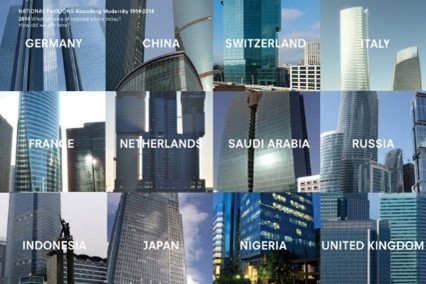
Rem Koolhaas: National Identity In Architecture
As said on ‘Psychology today’, a person’s “identity encompasses the memories, experiences, relationships and values that create one’s sense of self”. As much as this quote is in reference to a person’s identity it can also be related to architecture. For example, the style of buildings and placement in certain countries and cities can be seen as part of that locations identity as sometimes architects use a places’ history as inspiration for new buildings. Identity plays a large role in everyday life, from personal identity to a companies identity to a nations.
Utilities One explains the link between architecture and personal identity: “Physical spaces and places play a significant role in shaping our well-being and personal identity.” This quote really shows the importance of our surroundings and how it affects our identities. A colourful surrounding could make some very colourful and happy but it could also make others almost ‘rebel’ and dislike colour.
Even though identity is usually recognised within people it is also applicable to buildings, objects and places. Everything has different memories and characteristics which identify them.
Quotes:
“Identity encompasses the memories, experiences, relationships and values that create one’s sense of self” – Psychology Today “Physical spaces and places play a significant role in shaping our well-being and personal identity” – Psychology Today “It should be people-specific and should also represent the way of life of such people” – Chukwuali “Architecture As Identity” – Abel
References:
Abel, Chris. Architecture and Identity : Towards a Global Eco-Culture. Oxford England ; Boston, Architectural Press, 1997.
Adebayo, Anthony, et al. “Architecture: The Quest for Cultural Identity.” Facta Universitatis - Series: Architecture and Civil Engineering, vol. 11, no. 2, 2013, pp. 169–177, www.researchgate.net/publication/274829351_Architecture_The_quest_for_cultural_identity, https://doi.org/10.2298/fuace1302169a.
C. B. Chukwuali, "The influence of cultural pluralism on architectural practice in Nigeria: The content,
the context and the imperatives", Journal of Nigerian Institute of Architects, Enugu State Chapter, Vol. 1, No. 3, 2005, pp 13-20.
“Construction Spaces and the Influence on Personal Identity and Self-Expression.” Utilities One, 6 Nov. 2023, utilitiesone.com/construction-spaces-and-the-influence-on-personal-identity-and-self-expression. Accessed 20 Jan. 2024.
“Identity | Psychology Today.” Www.psychologytoday.com, www.psychologytoday.com/us/basics/identity#:~:text=Identity%20encompasses%20the%20memories%2C%20experiences.
Oxford Dictionary. “Oxford Languages.” Oxford Languages, Oxford University Press, 2023, languages.oup.com/google-dictionary-en/.
WA Contents. “ Rem Koolhaas: National Identity in Architecture,” WorldArchitecture.org, 26 Mar. 2014, worldarchitecture.org/article-links/pmezp/rem-koolhaas-national-identity-in-architecture.html.
During my research on identity I came to the realisation that even structures have their own identity and that they also help to create the identity of a place. For example, New York wouldn’t be the same without all its skylines which use their height to show off the powerful and wealthy identity of New York.
Chris Abel is a writer and educator who focuses on architectural practices, based in Malta. He has visited and taught in many big universities across the world. He is the author of a book called ‘Architecture and Identity’ which consists of a variety of his key essays that look into cultural and technological changes that are reshaping modern architecture. ‘Architecture and Identity’ is separated into three separate parts: Science and technology, Critical Theory, and Regionalism and Globalization. Within the section on Regionalism and Globalization he has a sub-section called “Architecture as Identity”. Within this chapter Chris looks at how architecture is used to show a places’ identity.
I strongly agree with, “Architecture as Identity” as a quote itself. This is because it shows that our architecture will and has always been used as a way to show a society or communities identity and what they find important and what they believe in, which they have done for centuries through the use of temples, churches and houses, etc.
I believe that as much as our personal identities are important, the identity of our architecture and what it tells others is and has always been equally as important. It shows off power, beliefs, religions and how our society works with each other.
Throughout my research I found that identity is such a broad subject that it is fairly tricky to pin point it to one specific topic. I tried to focus on identity within architecture as best I could to avoid going completely off-topic.
94 notes
·
View notes
Text
Fun with Geometry: Shapes You Didn’t Know You Needed
Geometry is far more than the basic shapes we learn in high school; it’s a world brimming with bizarre and captivating figures that push the boundaries of our imagination.
1. The Hypercube (Tesseract)
The hypercube, or tesseract, is the 4-dimensional analog of the cube. While we live in a 3-dimensional world, the concept of a fourth dimension has fascinated mathematicians and artists alike. A hypercube consists of 16 vertices, 32 edges, and 24 square faces, each one being a 3D cube in a higher-dimensional space.
In the real world, hypercubes don’t physically exist, but they serve as key tools in higher-dimensional geometry and theoretical physics. Think of them as a "spatial metaphor" for the kinds of higher-dimensional spaces used in string theory or machine learning. Mathematicians use them to explore the complex relationships between different dimensions. The tesseract also shows up in pop culture, notably in the movie Interstellar, where it represents the connection between time and space.
2. The Pentagon (Not Just in Architecture)
The regular pentagon (five sides of equal length and five equal angles) has a fascinating relationship with the golden ratio. If you draw diagonals within a regular pentagon, they intersect in such a way that the ratio of the longer segment to the shorter segment is the golden ratio (ϕ ≈ 1.618). This means that pentagons are not just aesthetically pleasing in architecture, they have deep connections to mathematical beauty.
In nature, sunflowers and pine cones exhibit pentagonal symmetry. The arrangement of seeds in the flower follows a Fibonacci spiral, and the spirals are governed by golden angle, which closely ties to the pentagon’s unique proportions.
3. The Dodecahedron
A dodecahedron is a regular polyhedron made up of 12 pentagonal faces, 30 edges, and 20 vertices. It is one of Platonic solids, which means each face is identical, and the same number of faces meet at each vertex. This geometric shape is not just abstract; it appears in various 3D modeling applications and is used in architecture, like in the London 2012 Olympic torch design.
What’s particularly fascinating is its appearance in pop culture. The dodecahedron serves as a crucial symbol in the book and movie adaptation of The Hitchhiker's Guide to the Galaxy (the "Meaning of Life" puzzle) and is part of a well-loved mathematical riddle known as the "dodecahedron paradox."
4. The Möbius Strip
The Möbius strip is a non-orientable surface with only one side and one edge, and it is a staple of topological geometry. The twist in a Möbius strip turns the concept of inside and outside on its head. Take a strip of paper, give it a half twist, and then join the ends. The result is a surface where you can trace your finger along its edge endlessly, without ever lifting it or reaching a boundary.
Mathematically, the Möbius strip is a symbol of non-orientability and plays a crucial role in knot theory and the study of 3-manifolds. The Möbius strip also sneaks its way into art and architecture, often used as a visual symbol of infinity or paradox in both visual and sculptural art forms.
5. The Klein Bottle
Another topological marvel is the Klein bottle, a non-orientable surface with no boundary. Unlike the Möbius strip, which has only one side, the Klein bottle essentially has a single continuous surface where both sides are connected in a higher-dimensional space. If you attempted to build one in 3D, it would have to intersect itself. However, it can be imagined in 4-dimensional space.
The Klein bottle's properties make it a critical concept in topology, with applications in advanced physics and geometry, particularly when studying the shape of the universe and space-time curvature.
6. The Truncated Icosahedron (Football Shape)
Have you ever wondered about the shape of a soccer ball? It’s a truncated icosahedron. This polyhedron has 12 black pentagonal faces and 20 white hexagonal faces, a geometric structure that makes it easy to create spherical objects with flat faces. The truncated icosahedron is a close-packed shape and appears in carbon molecule structures such as buckyballs (or fullerenes) used in nanotechnology.
7. The Archimedean Solids
The Archimedean solids are a set of 13 convex polyhedra, where each face is a regular polygon and the same number of faces meet at each vertex. These shapes, such as the icosahedron (20 faces) and octahedron (8 faces), pop up in all kinds of real-world applications, like in architecture and crystallography. In fact, many molecular structures (like the shape of viruses) reflect these highly symmetrical solids.
Next time you look at a soccer ball, admire a piece of modern art, or even browse through a movie with some mind-bending geometry, remember: the world is built on shapes you never knew you needed, and math is at the heart of them all.
#mathematics#math#mathematician#mathblr#mathposting#calculus#geometry#algebra#numbertheory#mathart#STEM#science#academia#Academic Life#math academia#math academics#math is beautiful#math graphs#math chaos#math elegance#education#technology#statistics#data analytics#math quotes#math is fun#math student#STEM student#math education#math community
17 notes
·
View notes
Text
Gigi Young's worldview and conspiracy theories make heavy use of a logical fallacy: appeal to nature. Many of her claims are based on an assumption that natural = ontologically good, and that unnatural = ontologically bad.
Let's consider some inherent problems with this:
It doesn't take a lot of effort to find natural things that are actually extremely harmful to us. Lead is a natural element, but it's extremely toxic to us. Many plants naturally evolved deadly toxins. Caves are perfectly natural, but they are terrible environments for humans to live in.
While there are some things that most of us would agree are natural (eg, a wild tree growing in the forest), there are still many things that people disagree on. For example, someone might consider a synthesized drug unnatural because it's man-made. But someone else might point out that while the active ingredient is synthesized, it's identical to one found in a plant; and besides, all chemical processes are inherently natural.
Asserting that unnatural things are inherently bad is begging the question - are they really inherently bad, though? Certainly there are clear-cut instances of things we might consider unnatural causing harm; for example, synthesized pesticides and herbicides that poison people and entire ecosystems. But what about hip replacements? What about adaptive devices? What about any form of architecture, period? Are houses and bridges bad because they don't construct themselves in nature?
Young's worldview is very simplistic and reductive, and her assertions begin to crumble under the smallest level of critical scrutiny.
#gigi young#conspiracy theorists#conspiracy theorist#logic#logical fallacy#appeal to nature#critical thinking
18 notes
·
View notes
Note
is there anything you want to learn/know more about ?
these are all things i'm actively trying to learn more about, but architectural history and theory, critical literary analysis, polar exploration history, and thanatology
138 notes
·
View notes